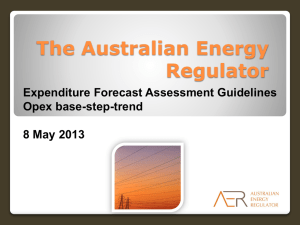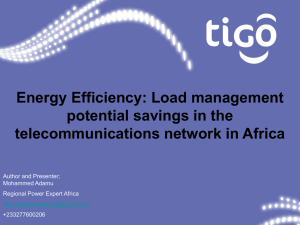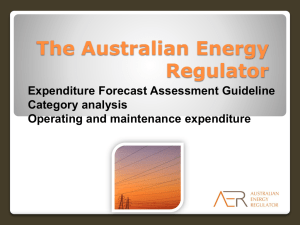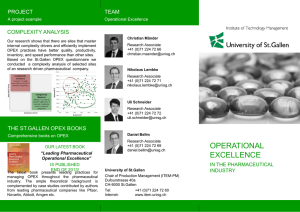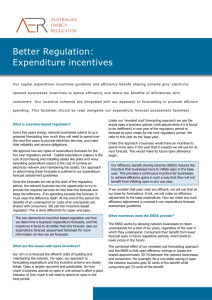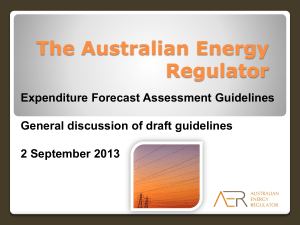Interaction between forecasting and incentive framework
advertisement
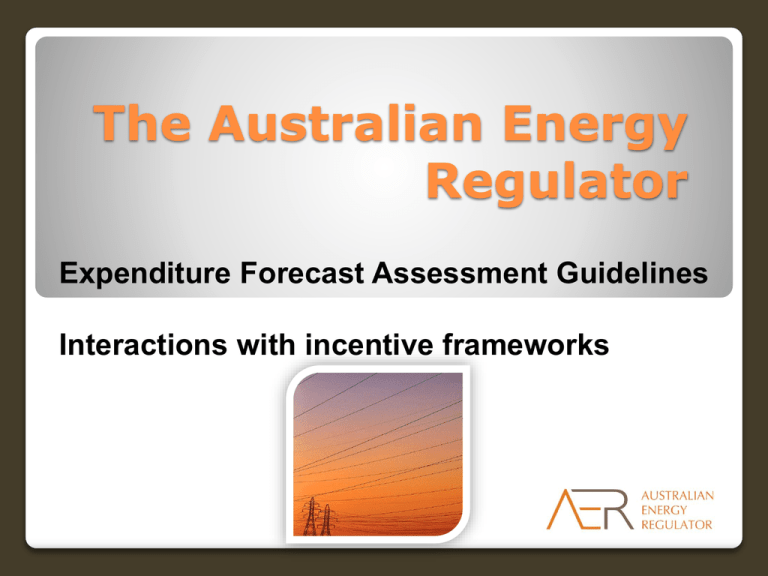
The Australian Energy Regulator Expenditure Forecast Assessment Guidelines Interactions with incentive frameworks Where are we today? 20 Dec 2012 •Issues paper 12 Feb 2013 •Initial Roundtable 28 Feb 2013 •Category selection 7/8 Mar 2013 19/20 Mar 2013 •Replacement/Demand •Connection/Customer driven capex 27 Mar 2013 •Repex/Augex models, demand forecasting 11 Apr 2013 •Opex category assessment 29 Apr 2013 •Interactions with incentive frameworks 8 May 2013 •Base-step-trend / Productivity change 16 May 2013 •Overheads, cost allocation and accounting 30 May 2013 •Expenditure setting process 2 The revealed cost approach AER’s preferred, ‘light handed’ approach Opex is forecast from actual expenditure in a ‘base year’ Approach relies on the EBSS providing a continuous incentive to reduce opex To ensure NSP retain its share of efficiency gains/losses base opex should not be adjusted 3 The revealed cost approach Revealed cost forecast + EBSS increments/ decrements = efficient opex forecast + NSP share of efficiency gains/losses By itself, the revealed cost opex forecast is not necessarily efficient: ◦ does not reflect efficiency gains made after the ‘base year’ (e.g. the final year) ◦ includes non-recurrent efficiency gains/losses made in the base year The revealed cost approach does not require these efficiency gains/losses to be identified 4 When should revealed costs not be used? If an NSP is not responding to the incentive to reduce opex then the revealed cost forecast will not be efficient Difficult to test—an NSP may be becoming more efficient, but it may be responding to another incentive 5 Proposed approach The revealed cost approach should be used if an NSP is found to be efficient However, if significant inefficiencies are identified in base opex these should be removed Desire to provide certainty/ clarity on thistwo key questions: 1. How will base year be assessed? 2. When will base year be decided/ adjusted? If base opex is adjusted then a different efficiency sharing mechanism is required 6 Base year efficiency assessment A two stage approach is proposed Stage 1 Stage 1 includes: ◦ Economic benchmarking ◦ Disaggregated category analysis Provides a high level assessment of efficiency May lead to another base year being adopted rather than further review 7 Base year efficiency assessment Stage 2 Stage 2 includes: ◦ Further, more detailed, benchmarking analysis ◦ Expert engineering assessment Further information would be sought from NSPs Base year expenditure would then be adjusted to ensure consistency with the opex criteria, taking into account the opex factors. 8 Base year efficiency assessment Opex category assessment – 11 April workshop Analysis of “direct” opex: ◦ Maintenance/ inspections; Emergency response; Veg management ◦ Standardised expenditure reporting categories, including detailed subcategories ◦ Standard volumes/ driver measures ◦ Normalisations/ NSP specific issues Overheads assessment – 16 May Economic benchmarking applications – 22 May (Opex “base-step-trend” – 8 May) 9 Timing considerations It is desirable to provide certainty on the assessment approach early in the determination process The NER requires the AER to outline in its F&A paper it proposed approach to the application of: ◦ the EBSS ◦ the expenditure forecast assessment guidelines The AER could state in its F&A paper whether it intends to use revealed costs (option 1) Alternatively it could outline its proposed base opex approach in its issues paper (option 2) Ultimately depends on when data are available 10 Timing considerations Option 1 As per NER provisions, AER would state in its F&A paper whether it intends to use the revealed cost approach or make adjustments to base opex This requires sufficient evidence to be available at the F&A stage Likely that this evidence would be in annual benchmarking reports First annual benchmarking report due to be published 30 September 2014, too late for upcoming resets 11 Timing considerations Option 2 The AER would state its base year approach in its issues paper, to be published 40 business days after a regulatory proposal has been submitted Would use whatever previous benchmarking data available at the time AER could also have regard to an NSP’s opex forecast/ regulatory proposal information when undertaking the assessment 12
